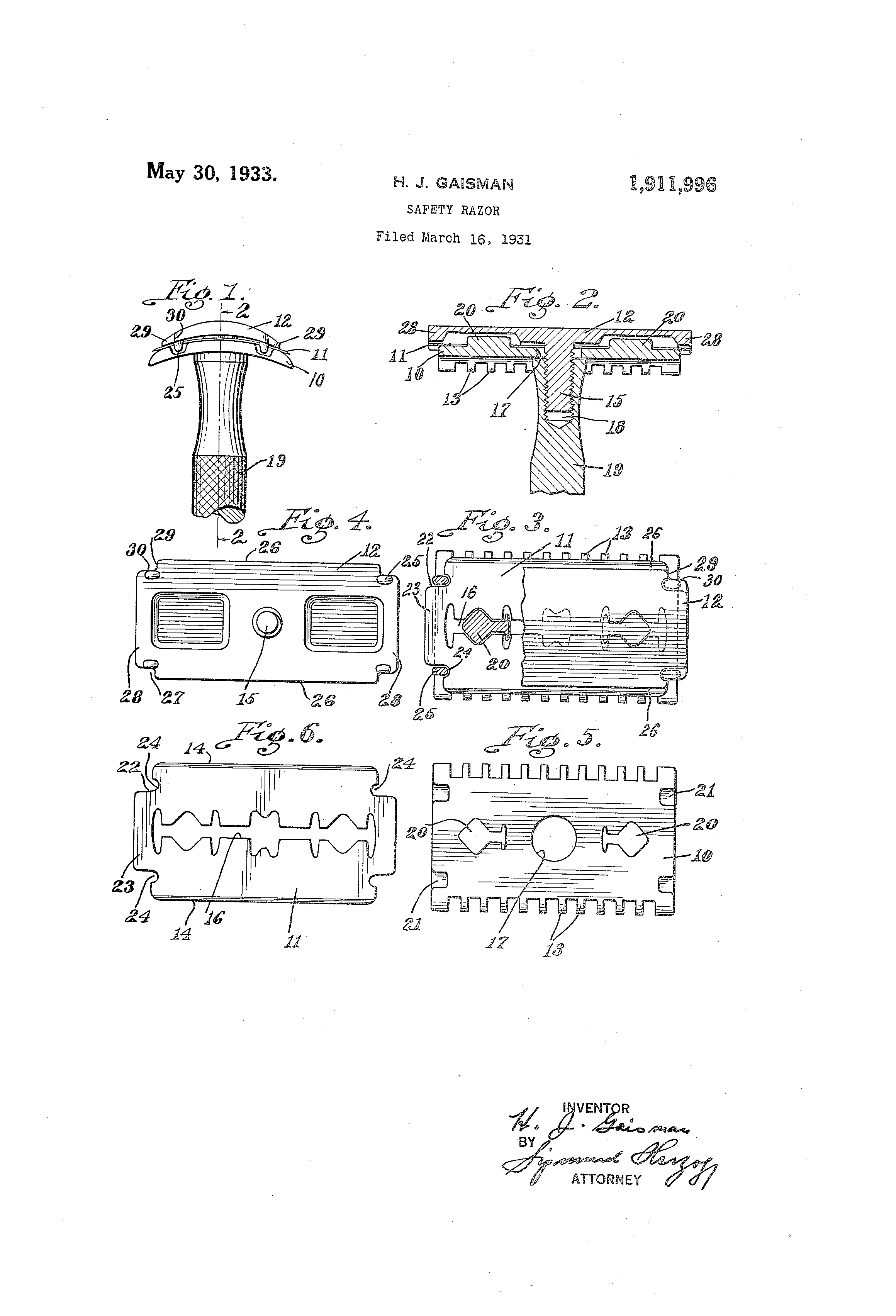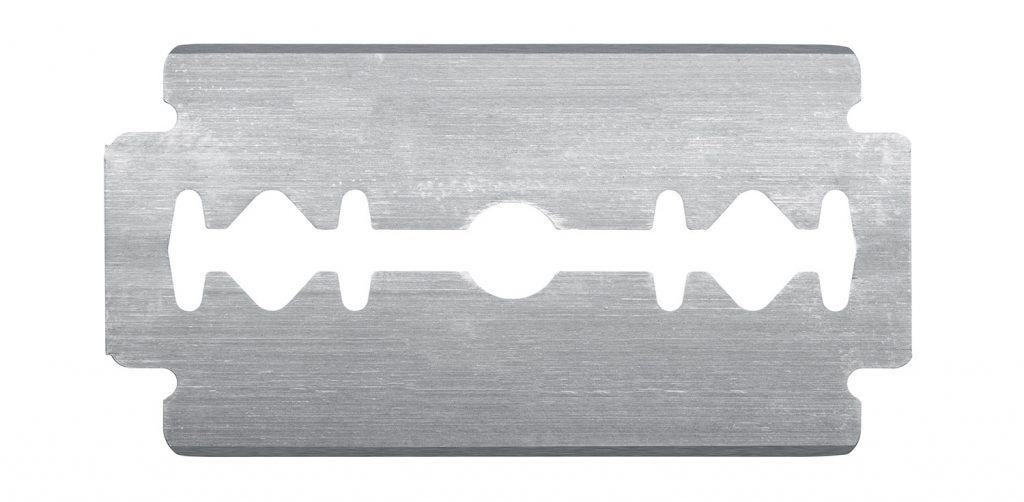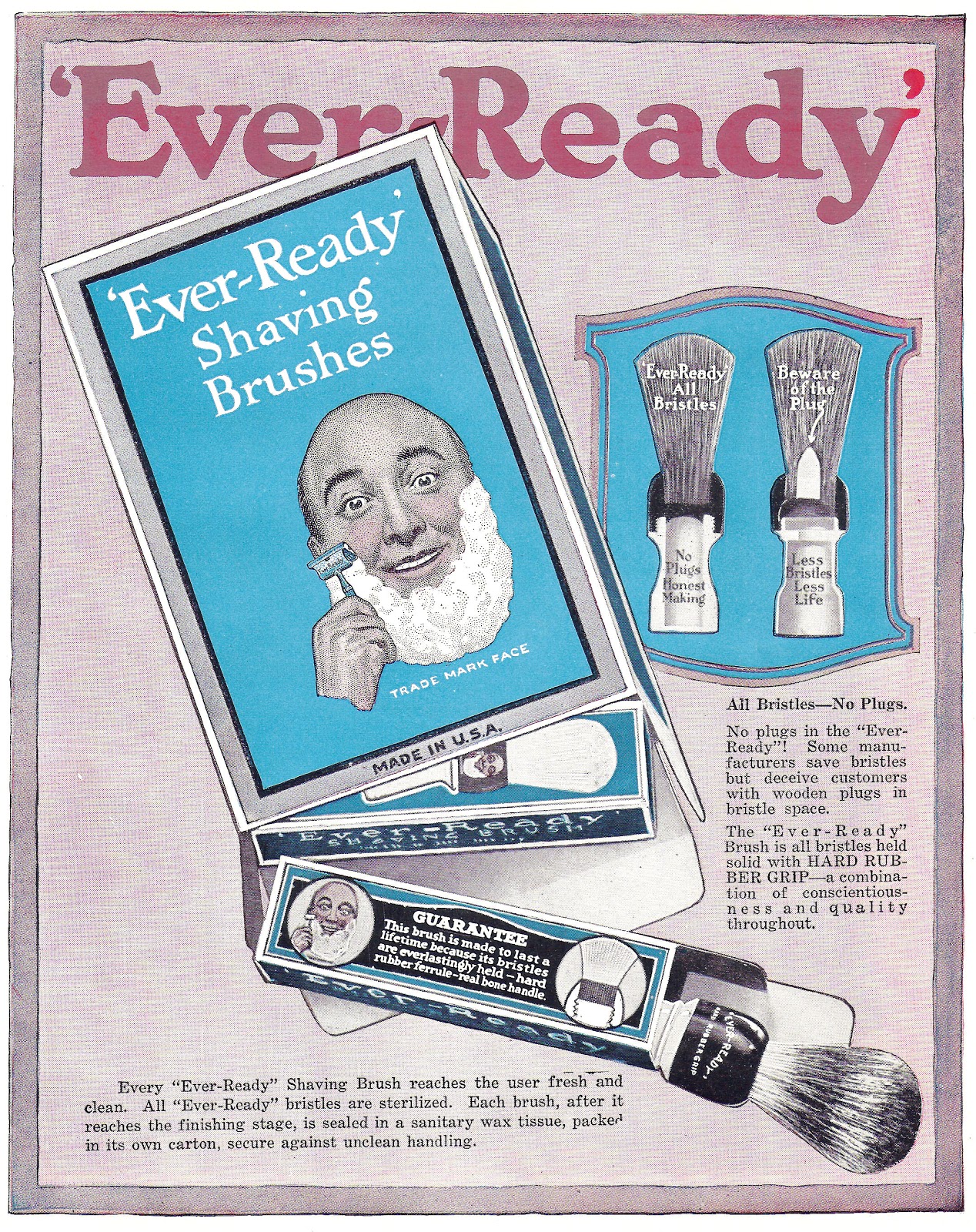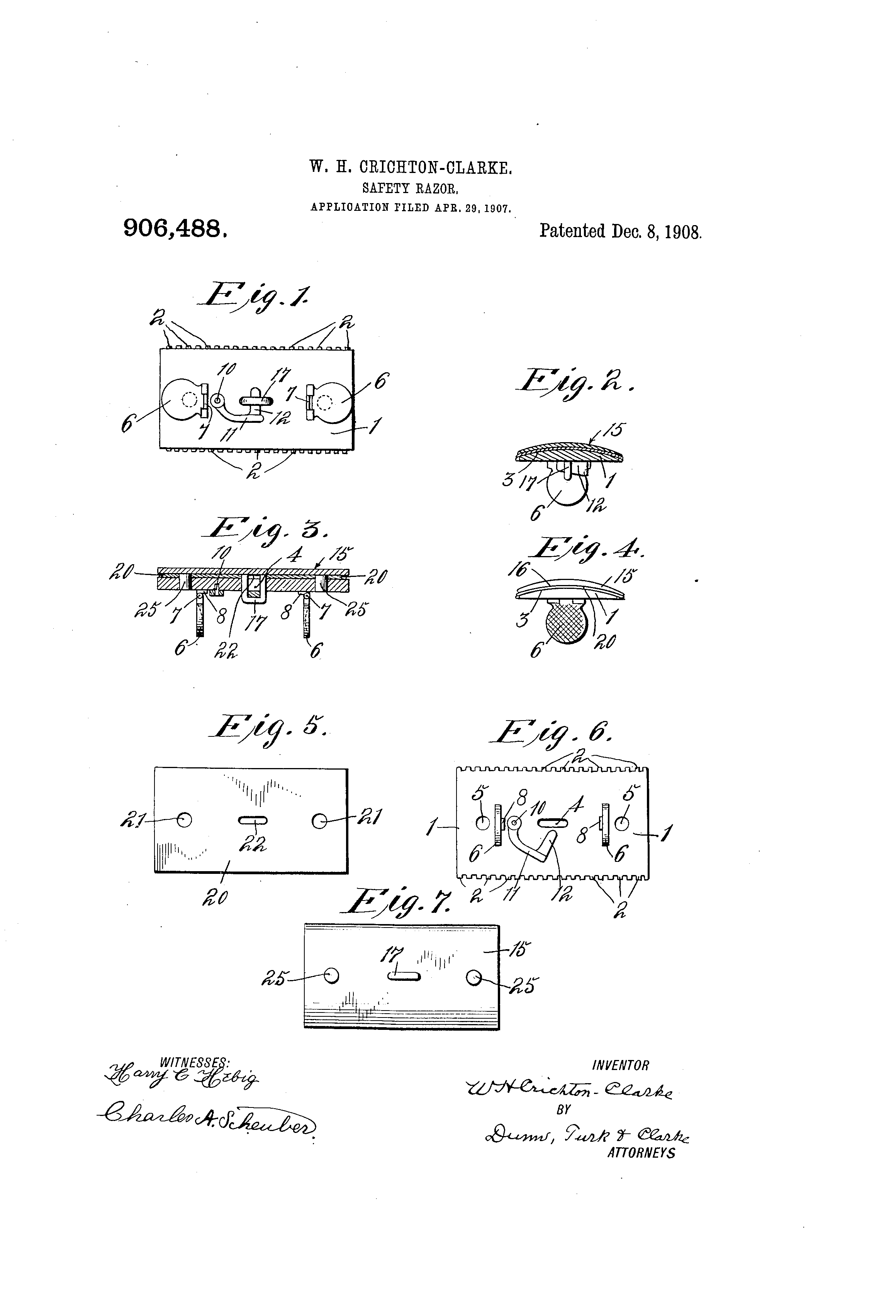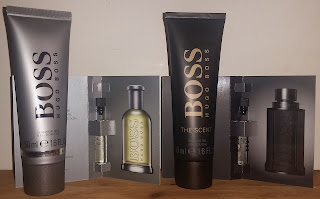The big selling point of the Rubberset brushes back in the day was that the bristles were set in rubber – which were claimed to be stronger, longer lasting and handling hot and wet better than other ways of setting the knot. So naturally they used those alleged benefits for all it was worth in their advertisements.
Tag Archives: Thoughts while shaving
The patent for the Goodwill – or rather; the Probak
Have a look a this Gillette Goodwill razor (picture found at Mr Razor’s site), paying special attention to the top cap:
Now; look at what Mr Henry Jaques Gaisman patented and later transferred to Gillette Co LLC, covering both the shape of the blade and the manner in which it was secured in the razor:
Look at the top cap, with the square cut-outs and corner posts. Look at the Goodwill again. Looks remarkable similar, do they not?
I do believe this is the patent that gave rise to the Goodwill – well, technically to the Probak.
Probak, I hear you say?
Turns out that the DE blade we know and love today isn’t really a Gillette blade, but the result of an attempt to work around Gillette’s patent on the three hole blade.
Mr Gaisman designed a blade that would work in his proprietary Probak razors (with oddly shaped studs – there was at least eight different base plates and top caps with different shaped studs) as well as in Gillette’s razors; but none of his razors could not accept a Gillette three hole blade, thus neatly sidestepping the patent.
With Gillette working on a similar concept at the time – using a slotted blade – the resulting patent conflict ended when Gillette bought out Probak Corp (and their parent company, AutoStrop Co). The stock of Probak razors were given away or sold cheaply (sources differs) as the Gillette Goodwill, and that is the name they are known under today.
To wrap things up, lets look at a Probak advertisement and compare to today’s DE-blade:

Apart from the shape of the middle hole – the X-shaped hole creates a lot of corners that ‘trap’ stress in the metal – the blade design is unmistakably Mr Gaisman’s, and not Gillette’s. And I only learned the story behind that because I found an old patent online… funny how things work sometimes.
An interesting old Ever-Ready brush advertisment
One thing is the neat looking vintage packaging shown in the advertisement, another and more intriguing thing is the cross sections. The “less honest” brush with the plug shows a way of using less hair in a brush of a given diameter that I’ve not even imagined before… I just assumed less dense brushes were simple less well packed.
Makes you wonder about the ‘glue plug’ one sometimes sees in cheap grocery store brushes over here… is it big because manufacture and quality control is sloppy, or to hide the fact that it’s a loosely packed brush?
European vending machine safety razor
Some weeks ago I was made aware – through a post on my favorite shave forum – of the fact that you used to be able to buy double edged safety razors in vending machines in Europe up until the early 1980’s. Despite living in Europe – well, Scandinavia – this was news to me. Granted, I didn’t start to shave until the late eighties, but still… possible they were only available in Germany; at least that is the one place I can find references to actually seeing one.
Sadly, apart from some pictures I found online, I know virtually nothing about this one apart from that I can gleam from the photos.
- It’s cheaply made, for starters – both the top cap and base plate is stamped sheet metal.
- Top cap have a riveted screw to secure it to the handle, pressed ridges for added strength, as well as half punched out “hanging chads” for locating the blade.
- The base plate is likely made from a simple stamping die – one punch and done.
- The handle seems to be the one part that has any ‘real’ machining done to it – it’s likely made from hexagonal stock, with one end rounded off, the other turned down to a cylinder and tapped for the screw thread.
- The handle is likely the most durable part of the razor – found one shaver online who like to use it with modern heads due to the weight of it.
I wish I know more about it… or even had one. If I had access to a half decently equipped metal workshop I could probably make some – as could any semi-decent machinist with a small press and a lathe – but there is no marked for a semi-disposable DE razor in this day and age.
Clemak safety razor

I do think that this advertisement is trying to push the idea that you could strop the Clemak once a week and have seven days of satisfying shaves. There are strong indications online that the Clemak used blades similar enough to the various GEMs and EverReady razors to be able to take a modern GEM blade – and the old style GEM blades were close enough to old wedge blades to take several rounds on the strop before wearing out.

Clemak was offered up – at least initially – as the cheaper and more British alternative to expensive safety razors, even if (as we’ll see later) it cost more than twice of the advertised five shilling if you wanted the full kit and kaboodle.
I figure we should go on a tangent right here for those less than familiar with old British coinage; one guinea was originally a gold coin worth one pound sterling, which was not minted after 1816. The name lived on and at the time of the Clemak it was referring to a value of one pound and one shilling – or about 21 shillings – which would be 1.05£ today (and keep in mind that the British resisted decimal currency because they figured it would be too complicated according to some of my sources). The guinea had an aristocratic overtone; professional fees and payment for land, horses, art, bespoke tailoring, furniture and other luxury items were often quoted in guineas – hence the question “Why pay a guinea?” – or in other words; why buy a luxery razor when the Clemak is just as good and affordable?
The images used in the advertisements points to the Clemak coming with an optional strop, as well as a selection of blades.
If you wanted to go all out – the razor, a dozen blade, the stropping machine, and a hide strop – you would have to come up with 10 shilling 6 pence – or around 97GBP (135USD) when adjusted for inflation and the change to decimal currency. Not cheap by any means, but nowhere near the prices we have to pay for a high end razor today – and still just half of the one guinea they wonder why you should spend.
Luxshave brushless cream advertisement
Slumming it – experiments with various types of soaps and no brush
Last week I was running a little experiments; lathering soap without the benefit of a brush, as well as trying more common soaps – basically just put soap on face, rub to lather and shave with a BiC disposable. This was in part inspired be a comment someone made a few weeks ago on my favorite shave forum, partly inspired by curiosity (the things I do sometimes…).
First I tried with my trusty Arko Shavestick; result were a very thin layer of lather little less cushioning than when I use it with a brush, but quite acceptable – if you’re used to canned goo at least.
Second out was using Prairie Creations’ Goat Soap hand soap. Results were… okay, if you’re not used to proper shaving. Thin and patchy, didn’t want to stay put on my face. Glide but no cushioning at all. Something like a cream soap might have yielded better results, but I used the bar I had handy.
Last out was my regular shower gel… and I have to admit, the shave was slightly better than the hand soap, and almost on level with one of my brushless creams; glide but no cushion, and no post shave effect at all. I know people who shave in the shower with shower gel, and after giving it a go I pity them.
As to summarise… well, apart from the “what am I doing?”, it shows that you can shave with virtually any soap… it just wont be as good as a proper shave.
If you’re going on an extended hike and can’t find the space to pack a brush, a stick of Arko can suffice to give you a half decent shave while doubling as a general soap – while a general soap likely wont do double duty as a shave soap. But if you’re that hard up for space, why bring a razor?
“Handle-less” safety razor patent
Way back in 1907 Mr William H Crichton-Clarke patented an improvement in safety razors on behalf of the Gillette Company. William had – as far as I can tell – two other shaving related patents; one for a simplified safety razor with fewer parts than the Gillette Old, and one for a blade-sharpening mechanism to hone the edge of razors blades.
The patent I’m having a look at today is one that would produce a very, very small razor consisting of basically nothing more than a top cap and a bottom cap with a blade fastened between them. Or in William’s own words;
…a strong, simple, durable, and inexpensive safety razor which is small and compact in construction, so that it can be carried conveniently in a vest pocket or the like.
The main claim of the invention is to have a razor with two folding handles that lie flat when not in use as shown in the drawing, and which can be held between thumb and index finger when shaving. For those who thinks that looks and sounds vaguely familiar, I covered a tiny little travel razor back in May of 2015 that works in much the same manner – so while the manner of execution is different, at least the concept got into production at one point.
Update: for more on the tiny little travel razor, see this post.
Lit face and burnt hands
Digging trough old patents can be a lot of fun… and somewhat scary at times; where they f-ing insane???
Lester E Norquist patented a solution to dark bathrooms in 1921 – by patenting:
a light in the form of a lamp that is adjustably and removably attached to the razor-blade holder in a position to illuminate the face when shaving.
Only one problem with that idea… he suggested using an incandescent bulb hooked up to the mains and then wrapped in a narrow tube of glass and metal.
To further qoute the patent application:
A completely operative face illuminating razor is provided for each user, which means that the handle and its reflecting hood are attached to a safety razor holder with a razor blade in it, and the sleeve and the glass cylinder and the socket with the electric lamp are in operative position within his beard.
A 40W bulb can bake a cake – a tungsten bulb in that watt-range is about 2% efficient, meaning that of the 40W you put in, 39.2W is radiated as heat. An incandescent bulb can easily reach 175°C (350°F), and neither glass nor metal insulate very well against temperatures like that.
See that thermal image? Now imagine wrapping your hand around that…
I do realise that Lester could have used a bulb with a lower wattage – but those are even less efficient. They will get just as hot; it’ll just take longer… and in the mean time it’ll cast less light towards the face being shaved.
The final nail in the coffin of this patent is the sheer thickness of the handle… even the Stahly Live Blade is slim in comparison. The sad fact is that Lester just was years ahead of his time; today we can easily put a LED-light and battery in a razor handle to light up the area we’re shaving if we so desire, without the bulk, heat and wireing that Lester E Norquist had to make do with.
Free samples – a great way to try scents
If your Better Half is halfway serious about make up and related products all is not lost if you go shopping with her, far from it.
Be patient, interested, pay a bit of attention and offer helpful suggestions… and Lo! free samples will come your way from the shop assistants, because they are trilled and overjoyed by a guy who isn’t moping in the corner looking like he hates his life!
If you keep frequenting the same shop on a regular or semi-regular basis, the employees will remember you, and also recall what samples you have gotten already – so you don’t end up with ten of the same – and will also ask your opinion on the samples you received so they can narrow the selection of new samples to offer… or offer you things that matches, like when I received matching Eau de Perfumes to a pair of shower gels I had already gotten.
I’ve built up a modest scent archive of samples so far by the simple expenditure of taking in interest in something my Better Half enjoy. Not only does it mean I get to spend more quality time with her, but so far I’ve also found at least two perfumes I would enjoy receiving for a birthday or Christmas.
And as an added bonus I know I can go to that shop my Better Half prefers, smile at one of the girls working there and know that if I ask for suggestions for a make-up item or scent I can give as a gift to my Better Half, they will hook me up with something that my Better Half will enjoy receiving and using.
It’s a win-win-win all around!






